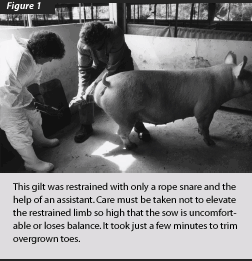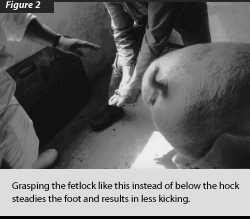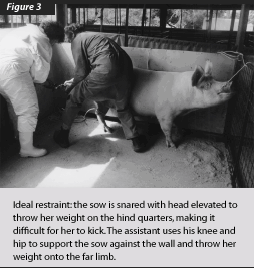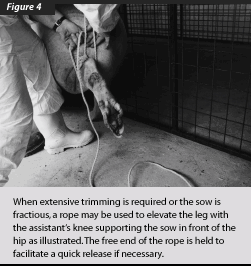Practice tip – Restraint for hoof trimming – Nov/Dec, 1999
Practice tip |
Barb Frey, DVM and Yvonne Sprey
BF: Portec Australia Pty Ltd, P.O. Box 331, Belmont WA 6104 Australia; email: bfportec@highway1.com.au. YS: Pigz Consultancy, Woodside Road, Oxford, Canterbury, New Zeland
Sow lameness and the associated pain and discomfort are underestimated as contributors to reproductive losses and premature culling. For example, 18% of sows removed during a national sow wastage study were culled for lameness.1 Many causes of lameness have been documented.2 A proportion of these are attributable to hoof lesions such as overgrowth, corns, and hoof abscesses. Such lesions may be associated with floor type, poor hygiene, conformation, injury, or lack of exercise. However, they may be treated or prevented by corrective trimming, as illustrated in Figures 1-6. The economics of this procedure will be dictated by the cost of replacement stock and the value of culls.
Equipment
Hoof knives are not recommended except for paring out a localized lesion. The main tool to use for hoof trimming is either a one-handed pair of nippers, or a two-handed pair (such as those used for cattle) with an assistant holding the hoof. Ear protection and leather gloves are recommended.
Restraint
Chemical restraint is usually only required when facilities or available assistance preclude manual restraint, the extent of the lesion requires prolonged effort, the animal is a pet, or the owner prefers it. It is difficult to trim a foot squarely when an animal is recumbent.
Problems with restraint include:
- fearful pigs accustomed to aversive handling. Such pigs are also difficult to restrain chemically;
- leg elevated too high or pulled out to the side too far for the animal’s comfort. This throws off its center of balance and it struggles in fear of falling. This also encourages it to lean its weight on the handler. It tires more quickly, as well;
- when the animal’s head is free, it struggles. Swine have a lot of strength in the neck and weight in the head, which needs to be firmly elevated to square its center of balance;
- when the head is restrained uncomfortably or too high, it can throw off its balance;
- slippery floor;
- many lamenesses are bilateral, especially when they are related to conformation flaws. An animal can simply be more lame on one leg than the other. This makes it painful to bear all its weight on the other leg. I suspect this is the problem with most pigs that struggle despite quiet handling and firm supportive restraint. Such animals often ‘go lame’ in the opposite limb a few weeks after trimming the affected side. For this reason, I always check both.
The most important thing is having a person to support the pig. It really makes all the difference. Done properly, trimming takes little time for simple hoof overgrowth. Timely correction of hoof overgrowth and mild lesions in younger stock can reduce culling due to lameness.
References
1. Paterson RA, et al. Investigations into death and excessive culling of sows in Australian pig herds. Proc Aus Assoc Pig Vet. 1996: 65-70.
2. Dewey CE, et al. Clinical and postmortem examination of sows culled for lameness. Can Vet J. 1993;34:555-6.




